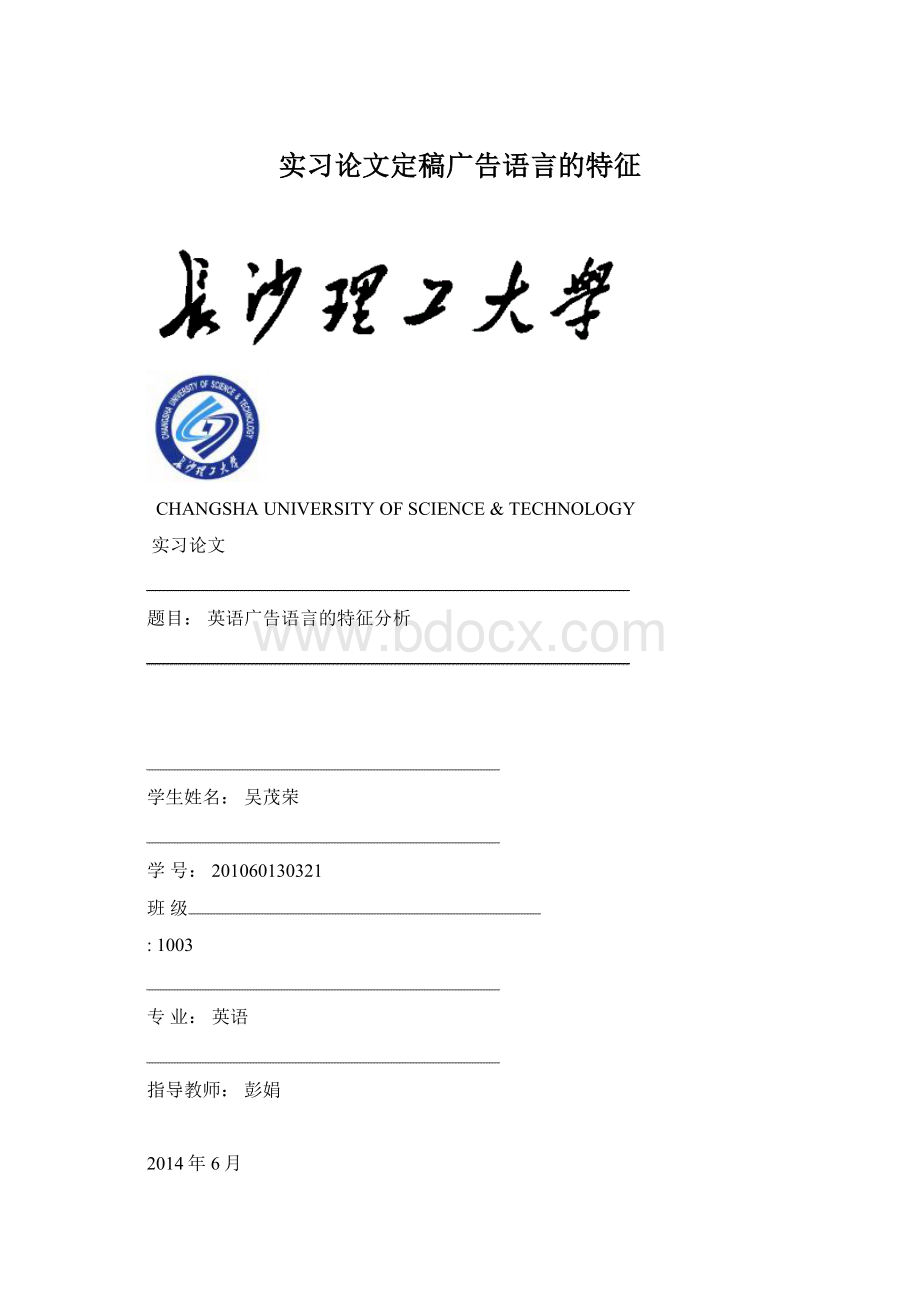实习论文定稿广告语言的特征.docx
《实习论文定稿广告语言的特征.docx》由会员分享,可在线阅读,更多相关《实习论文定稿广告语言的特征.docx(14页珍藏版)》请在冰豆网上搜索。

实习论文定稿广告语言的特征
CHANGSHAUNIVERSITYOFSCIENCE&TECHNOLOGY
实习论文
题目:
英语广告语言的特征分析
学生姓名:
吴茂荣
学号:
201060130321
班级
:
1003
专业:
英语
指导教师:
彭娟
2014年6月
PRACTICETHESIS
(Grade2010)
ANANALYSISOFLANGUAGEFEATUREINENGLISHADVERTISEMENTS
Name:
WuMaorong
Number:
201060130321
Class:
1003
Tutor:
PengJuan
Department:
SchoolofForeignLanguages
DateofCompletion:
June2014
英语广告语言的特征分析
摘要
本文旨在通过对书面英语广告的语言分析总结出广告英语在词汇﹑句法﹑篇章上的语言特点。
为了使研究从数据出发得出科学结论,本文作者建立了一个拥有60篇各类广告的小型语料库。
通过对此语料库中日用品广告﹑科技设备广告﹑服务业广告的深入细致的定量和定性分析,总结出广告英语在此三类广告中的相同点与不同点,并且根据语言的意义,风格及功能解释广告英语的共性以及广告英语在不同类型广告中的特殊性。
本文共分五个部分,第一部分和第五部分分别为介绍与总结,中间三个部分为本文核心,分别展开广告英语在词汇﹑句法﹑篇章三个层面的分析。
本文的结论均来自于对语料库的分析。
整个研究从数据出发,由数据驱动,由此进行语言学上的分析与概括。
本文作者衷心希望此论文的分析结果能给英语广告的写作者以及广告英语的学习者提供帮助。
关键词:
广告英语;词汇;句法;篇章
ANANALYSISOFLANGUAGEFEATURESINENGLISH
ADERTISEMENTS
ABSTRACT
ThispaperpresentsananalyticalstudyofthelanguagefeaturesofEnglishadvertisementsatlexical,syntacticanddiscourselevels.Inordertoconductadata-drivenstudy,theauthorbuildsacorpusof60Englishadvertisements.Itishopedthatthroughthedetailedsurveyofthreetypesofadvertisements:
namely,dailyconsumergoodsads,technicalequipmentads,serviceads,similaritiesanddifferencesinadvertisinglanguagefeaturescanbesummarizedandpossiblereasonswillbegiveninthelightofthemeaning,andfunctionoflanguage.
Thispaperwillbepresentedinfiveparts.Thefirstpartistheintroductionandthelastconclusion.Thefocusofthepaperislaidonthethreemiddlepartswhichrespectivelyanalyzelanguagefeaturesatlexical,syntacticanddiscourselevels.Theconclusionofthispaperisdrawnfromthedataanalysis.Intheanalysis,examplesfromthecorpuswillbegiven;figures,tablesandgraphswillalsobeofferedtomakethepaperunderstandableandpersuasive.
ItishopedthatthestudycanshedlightonthelanguagefeaturesofadvertisementsandalsoprovidehelptocopywritersandadvertisingEnglishlearners
KeyWords:
EnglishAdvertisements;Lexical;Syntactic;Discourse
Contents
Introduction1
1LexicalFeatures2
1.1Classificationofadvertisinganditsaudience2
1.2Similaritiesatthelexicallevel3
1.2.1Fewverbsareused3
1.2.2Fewverbsareused4
1.3Differencesatthelexicallevel4
1.3.1Selectionofadjectives5
1.3.2Compoundwords5
1.3.3Useofpronouns5
2Syntacticalfeatures7
2.1Similarities7
2.2Differences9
3Discoursefeatures11
3.1BodyCopyofanAdvertisement11
3.2DifferencesinBodyCopies11
Conclusion14
Bibliography16
Acknowledgements17
Introduction
Weliveinaworldofadvertising.Aspotentialconsumers,weareendlesslybombardedwithallkindsofproductorserviceinformationfromvariousmediaincludingnewspapers,magazines,television,radio,postersandInternet,etc.Advertisingprovidesavaluableservicetosocietyanditsmembers,becauseitdefinesforconsumersthemeaningandtheroleofproducts,services,andinstitutions.Itindicatesthedifferencethatexistsbetweenbrandsofproductsandalternativeservices,aswellasthedistinguishingcharacteristicsofcompaniesandinstitutions.Advertisingalsotellstheconsumerwhataspecificproduct,brandorserviceshoulddowhenitisusedandthushelpshimorhertounderstandandevaluateexperiencewiththeproductsandservicesthatheorsheuses.Ontheotherhand,bymakingpeopleawareofproducts,serviceandideas,advertisingpromotessalesandprofits.Finally,advertisingisoneofthemajorforcesthatarehelpingimprovethestandardoflivingaroundtheworld.Combinedwithallthesecommunicational,marketingandsocialfunctions.Advertisingbecomesindispensableinthemodernworld.
Naturally,advertisementsinEnglishhavebecomeanimportantmeansofcommunicatingideas,demonstratingavarietyoflinguisticfeaturesofitsown.Thepresentstudyattemptstoexaminethesefeaturesatthelexical,syntacticanddiscourselevels,inthehopeofbringingthemtolightand,thereby,offeringhelptoadvertisementwritersandlanguagelearners.
1LexicalFeatures
AccordingtotheDefinitionCommitteeofAmericanMarketingAssociation(方薇,1997:
2)[1],advertisingisdefinedthatadvertisingisthenopersonalcommunicationofinformationusuallypaidforandusuallypersuasiveinnatureaboutproducts,servicesorideasbyidentifiedsponsorsthroughthevariousmedia.
1.1Classificationofadvertisinganditsaudience
Generallyspeaking,advertisementscanbedividedintotwotypes:
publicrelationadsandcommercialads.Theformertriestoadvocatereputationforasocialgroup,whosepurposeistoleaveafavorableimpressionuponthepotentialaudience.Thelatterleadstotheactofpurchasingtheproductsorusingtherecommendedservice.Commercialadsaremuchmorepresentedthroughmassmediaforthereasonthatmanufacturersandcompaniesarewillingtospendalargesumofmoneytomakeacertainproductknownortoboosttheimageofacertainbrand.Insomecases,competitors,likeCoca-colaandPepsi,evensparenoexpensetolaunchadvertisingcampaignstowinoverthemarketshare.Commercialadvertisingcanalsobedividedaccordingtothetargetaudienceintotwogroups:
consumeradvertisingandbusinessadvertising.Mostoftheadsinthemassmediaareconsumeradvertisements.Theyaretypicallydirectedatconsumers.Bycontrast,businessadvertisingtendstobeconcentratedinspecializedbusinesspublications,professionaljournals,tradeshowstargetingatacertaingroupofpeopleinvolvedinsomebusiness.
Actually,advertisingworkseffectivelysomeofthetimeanddoesn’tworkothertimes.Thesinglecrucialreasonthatadvertisingdoesnotworkisthatinspecificinstancestheinformationitconveysneverreachestheconsumeratall,orisjudgedbytheconsumertoberedundant,meaningless,orirrelevant.Forexample,amotorbikeadvertisementwillprobablybeinvisibletohousewivesonthelookoutfornewcutlery.Socialstatusandindividualinterestdecidethatconsumergoodsadsaremainlytargetingatwomenwhiletechnicalequipmentadsarelargelyaimingatmen.Theamountofsharedknowledgebetweentheadvertiserandtheaudiencetogetherwiththethinkinghabitoftheaudiencedirectlyinfluencestheadvertisinglanguage.Sinceproductsandaudiencechangeineveryadvertisementinordertoachievehighadvertisingeffectiveness,languageuseddiffersindifferenttypesofadvertisements.Thus,inthispaperwediscussnotonlythesimilaritiesoflanguagesharedbyalltypesofadvertisementsbutalsodifferencesoflanguageusedindifferentkindsofadvertisements.
1.2Similaritiesatthelexicallevel
Inordertomaketheinformationaccessibletoaudienceeffectively,thechoiceofwordsinadvertisingisverycautiousandskillful.Theaimoftheadvertiserisquitespecific.Hewishestocapturetheattentionofthemembersofamassaudienceandbymeansofimpressivewordstopersuadethemtobuyaproductorbehaveinaparticularway,suchasgoingtoHawaiiforalltheirholidayneeds.Bothlinguisticandpsychologicalaspectsaretakenintoconsiderationinthechoiceofwords.Sharingthesamepurposeofadvertising-tofamiliarizeorremindconsumersofthebenefitsofparticularproductsinthehopeofincreasingsales,thetechniquesusedatthelexicallevelbyadvertisersdonotvarymarkedly.Thefollowingpointsaresomeprominentsimilarities.
1.2.1Fewverbsareused
G.N.Leech,Englishlinguist,lists20mostusedverbsinhisEnglishinAdvertising:
LinguisticstudyofAdvertisingInGreatBritain(方薇,1997:
20)[1].Theyare:
make,get,give,have,see,buy,come,go,know,keep,look,need,love,use,feel,like,choose,take,start,taste.
AllthesefrequentlyusedverbsaremonosyllabicandmostofthemhaveAnglo-SaxonoriginthatisthecommoncoreofEnglishvocabulary.LinguisticstudyshowsEnglishnativespeakerstendtousewordsofAnglo-Saxonorigin,becausenativewordshavecomparablystablemeaning[2].Inadvertising,thesesimplewordscanwintheconsumersbytheirexact,effectiveexpressionandakindofcloseness.Etymologicalstudiesshowthatthe20verbslistedbefore,exceptuseandtastewhicharefromancientFrench,allareAnglo-Saxonorigin.Eventhetwowords,useandtastehavelongbecomeindispensablelexicalitemsinthestockofcommoncorevocabularyoftheEnglishpeople,developingtheirstablemeaningandusage.
1.2.2Fewverbsareused
Aclosescrutinyofrecentadvertisementssuggeststhatthesoft-selltechniqueisnowpopular.Bysoft-selltechniquewemeantheonethatfavorsamoreemotiveandlessdirectiveapproachtopromoteaproduct,mainlyfocusingonthebuildingofbrandimage.Asaresult,emotivewords,mostofwhicharepleasantadjectives,aregreatlyencouragedtouse.New,good/better/best,fresh,free,delicious,sure,full,clean,wonderful,special,crisp,real,fine,great,safe,andrich.Theseadjectiveshelptobuildapleasantpictureinreaders’mindsandmanagetocreateabeliefinthepotentialconsumer:
IfIbuythisproductorifIchoosethisservice,Iwillleadabetterlife.Inaddition,comparativesandsuperlativesoccurtohighlighttheadvantageofacertainproductorservice.Forexample:
Nothingcomesclosertohome.(VegetableandChickenPastaBake).
1.3Differencesatthelexicallevel
Whilewefoundquitealotofsimilaritiesinthechoiceofwords,wehavealsofoundsomedelicatedifferencesinthechoiceofwordsinthethreetypesofadvertisementsasclassifiedbefore:
dailyconsumergoodsads,technicalequipmentads,andserviceads.
Language,asacommunicativetool,isnotonlytoimpartinformation,tocommunicateide